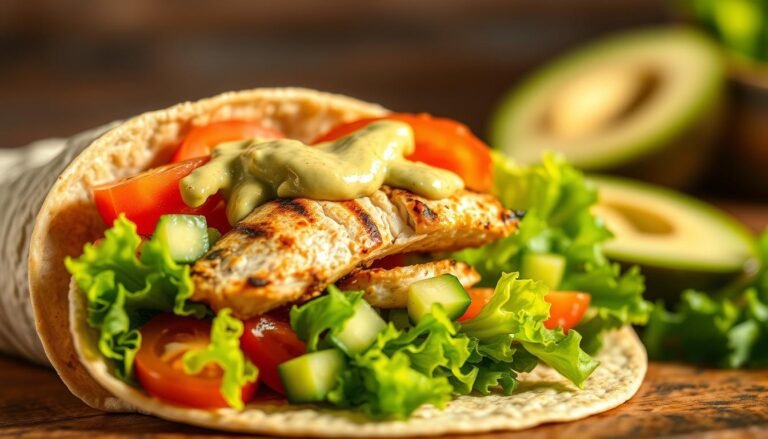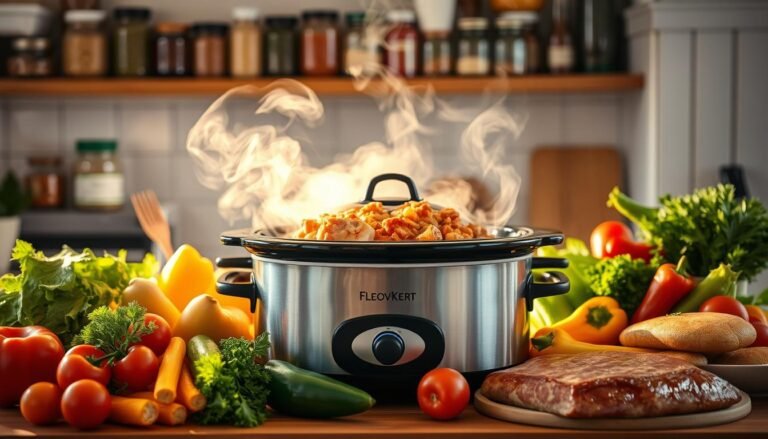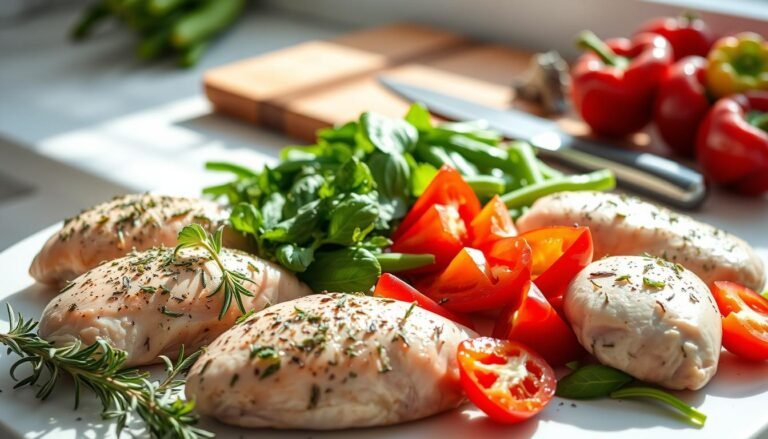Healthy Cheesecake Recipe: Satisfy Your Sweet Tooth
Table of Contents
Craving cheesecake but want a healthier choice? Our healthy cheesecake recipe offers rich, creamy taste with less guilt. No more guilt-free dessert worries. Say hello to a low-calorie cheesecake full of nutrients.
This guide shows you how to make a nutritious cheesecake for any time. You won’t miss out on flavor with better ingredients.
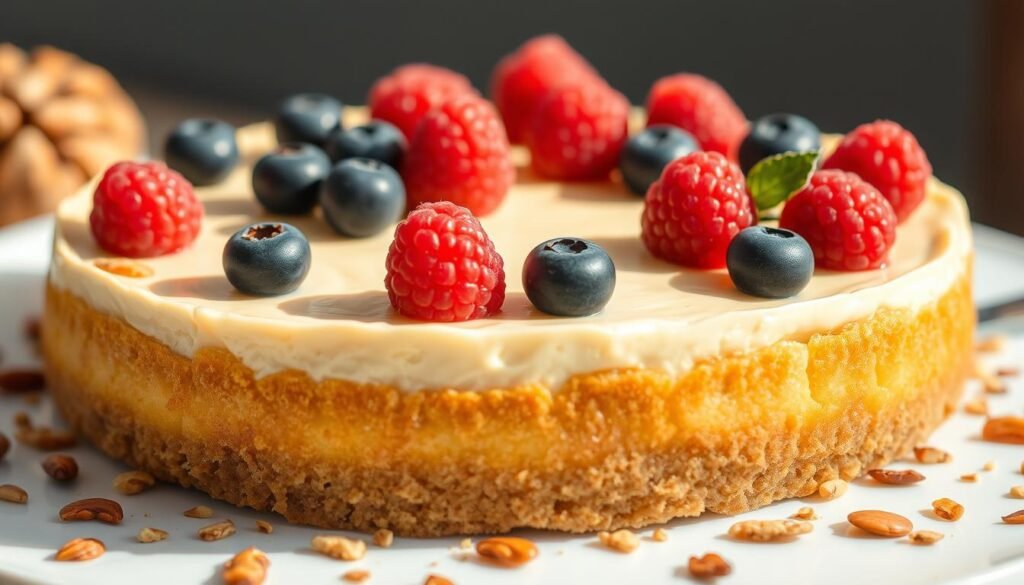
Key Takeaways
- Cut calories without sacrificing indulgence with smart ingredient swaps.
- Learn how to make a dessert that’s both tasty and nutritionally balanced.
- Discover options for vegan or gluten-free dietary needs.
- Enjoy a recipe that highlights fresh, whole food ingredients.
- Master techniques to keep this healthy cheesecake recipe fresh and flavorful.
Why Choose a Healthy Cheesecake Recipe?
Traditional cheesecakes are high in calories, saturated fat, and sugar. They can make you feel sluggish or guilty. But, our healthy dessert alternatives offer a guilt-free treat.
The Problem with Traditional Cheesecakes
Classic cheesecakes use a lot of cream cheese, sugar, and butter. These ingredients add empty calories and fats. Many also have artificial additives, making them unhealthy.
Health Benefits of Our Lighter Version
Our reduced-fat cheesecake uses Greek yogurt instead of cream cheese. This reduces saturated fat by 40% and keeps it creamy. We also use lower sugar cheesecake methods, like monk fruit or dates, to cut sugar by up to 60%.
Our cheesecake has more fiber from almond crusts and probiotics from yogurt. These add to its nutritional value.
Guilt-Free Indulgence: Having Your Cake and Eating It Too
Enjoying desserts shouldn’t make you feel guilty. Our recipe balances taste and health. You can enjoy cheesecake without worrying about calories or sugar.
Nutritional Breakdown of Our Healthy Cheesecake
Discover thecheesecake nutrition factsthat make our recipe a standout choice. Unlike traditional versions loaded with sugar and fats, our approach balances taste with wellness. Here’s how it stacks up:
Calorie Comparison: Traditional vs. Healthy
A standard 100g slice of classic cheesecake packs 350–450 calories. Ourlow-calorie dessert comparisonshows our version delivers just 200–250 calories—without sacrificing creaminess. Swap refined sugars for natural sweeteners like honey or maple syrup to cut empty calories.
Protein, Fat, and Carbohydrate Profile
Ourprotein-rich dessertuses Greek yogurt and almond flour, boosting protein to 12g per serving. Healthy fats from avocado and nuts replace heavy cream, keeping saturated fats low. Net carbs drop to 20g thanks to fiber-rich flaxseed in the crust.
Vitamins and Minerals You’ll Get
Each bite delivers calcium from yogurt, vitamin C from citrus zest, and magnesium from nuts. Thehealthy cheesecake macrosinclude iron from chia seeds and antioxidants from berries, turning dessert into a nutrient-packed treat.
With these upgrades, you enjoy a dessert that fuels your body while satisfying cravings. Check the full cheesecake nutrition facts chart to see how every ingredient contributes to a balanced plate.
Essential Ingredients for a Healthier Cheesecake
Creating a healthier cheesecake begins with the right ingredients. We’ll explore what makes a cheesecake better for you without losing taste. Using Greek yogurt cheesecake bases and natural sweeteners for baking helps reduce sugar and fat.
- Base Options: Replace heavy cream cheese with low-fat cream cheese alternatives like Neufchâtel. Or mix in ½ cup nonfat Greek yogurt per 8-ounce cream cheese block.
- Sweeteners: Use date syrup, stevia, or Lakanto’s natural sweeteners for baking. They offer less sugar than refined sugar.
- Crusts: Make a whole grain crust with oats, quinoa flakes, or Bob’s Red Mill whole-grain blends. They add fiber without being heavy.
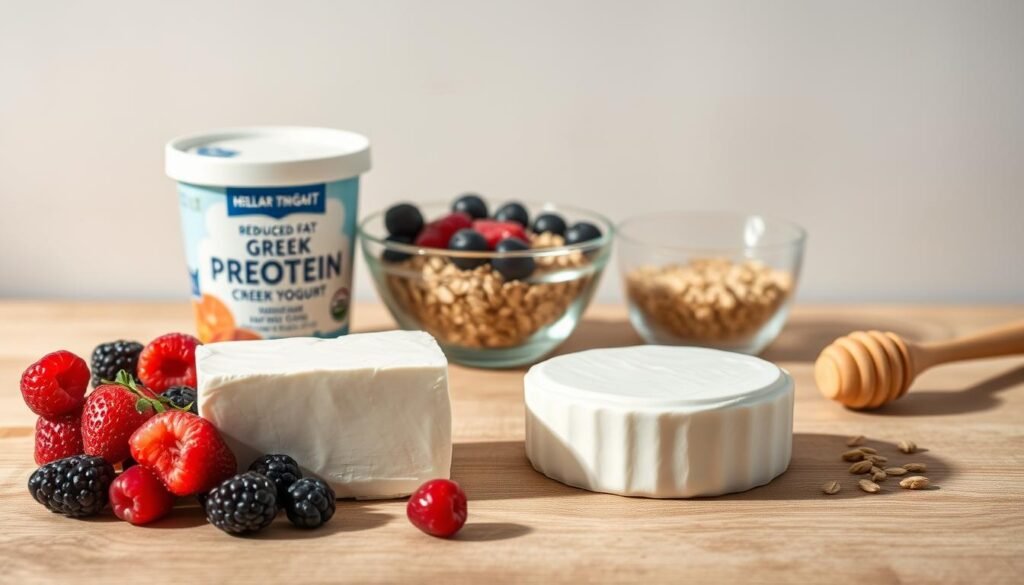
Quality fats like almond butter or avocado make Greek yogurt cheesecake creamy. Choose high-protein yogurts like Chobani or Fage. Store ingredients right: freeze yogurt in ice cube trays and keep whole grain crust mixes in airtight containers for up to a month. Try spices like cinnamon or vanilla bean paste to enhance flavor naturally. Each choice helps create a dessert that’s both tasty and healthy.
Healthy Swaps That Don’t Sacrifice Flavor
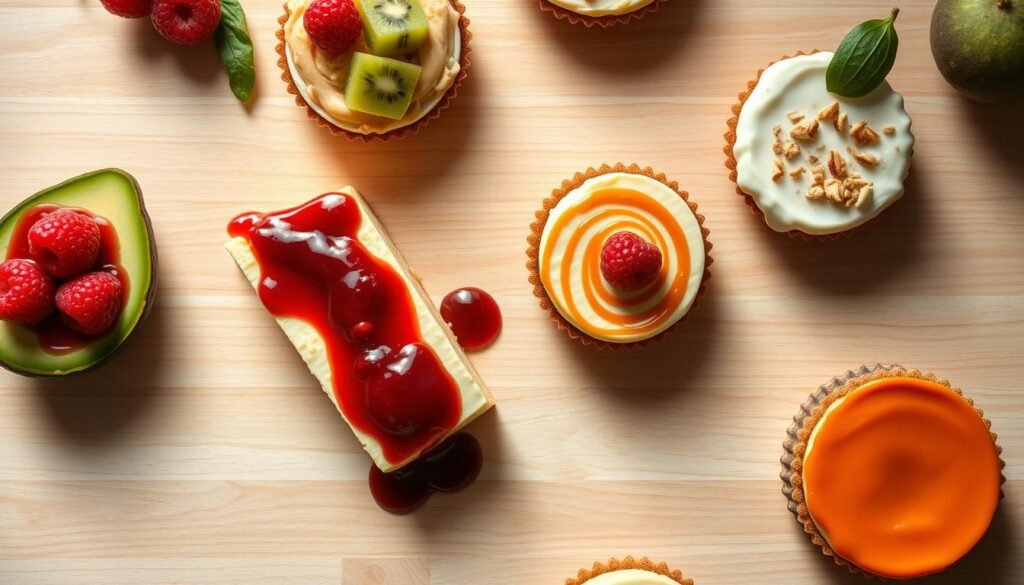
Make your desserts healthier with healthier baking substitutions that don’t lose flavor. These smart changes let you enjoy cheesecake without losing texture or taste.
Greek Yogurt Instead of Cream Cheese
Replace up to 50% of cream cheese with Greek yogurt dessert recipes to reduce fat and increase protein. Use full-fat yogurt for creaminess. Try mixing it with reduced-fat cream cheese for a light base. Add lemon or vanilla for extra freshness.
Natural Sweeteners vs. Refined Sugar
Choose natural sweetener conversion chart options over refined sugar. Here’s a comparison of popular alternatives:
| Sweetener | Sweetness vs. Sugar | Substitution Ratio | Notes |
|---|---|---|---|
| Maple Syrup | Equal sweetness | 3/4 cup syrup = 1 cup sugar | Add 1/4 tsp baking soda to balance acidity |
| Coconut Sugar | 60% as sweet | 1:1 by volume | May add subtle caramel notes |
| Stevia | 200x sweeter | 1 tsp = 1 cup sugar | Use liquid stevia for easier mixing |
Whole Grain and Nut-Based Crusts
Replace graham crackers with crushed oats or almond flour. Try Bob’s Red Mill Gluten-Free Oats for a buttery, fiber-rich crust. Mix in melted coconut oil and cinnamon for depth without added sugars.
Plant-Based Options for Vegan Variations
Explore vegan cheesecake alternatives like cashew cream or full-fat coconut milk. Brands like So Delicious Coconut Milk make velvety bases. Silken tofu adds protein in tofu cheesecakes—blend until smooth before baking.
Step-by-Step Healthy Cheesecake Recipe
Ready to bake the easy healthy cheesecake everyone will crave? Follow these simple steps using healthy baking techniques to master the no-crack cheesecake method. This guide ensures a silky texture and zero guilt.
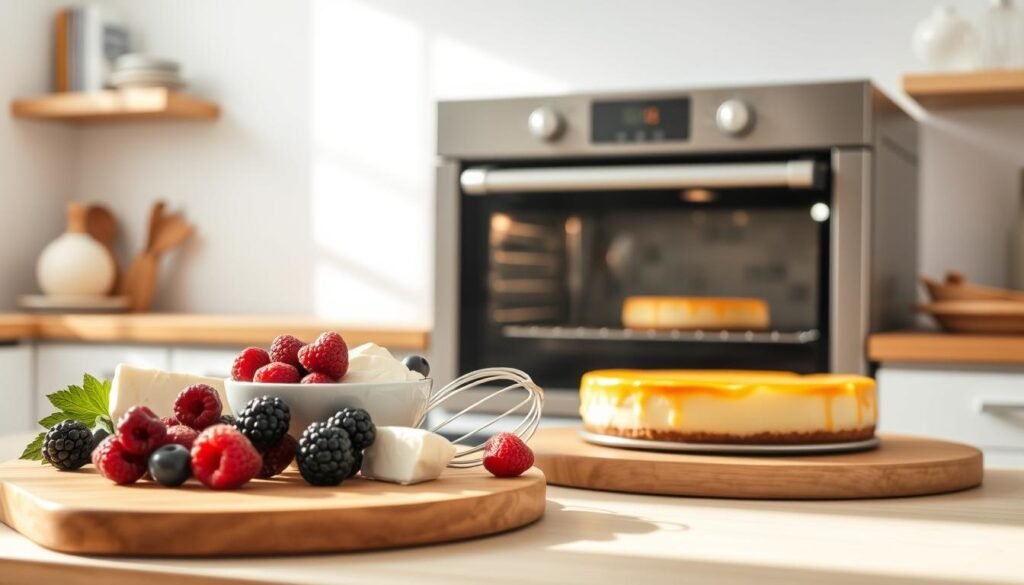
Preparing Your Crust
Start by blending 1 cup almonds, ½ cup oats, and ¼ cup dates in a food processor until crumbly. Press the mixture firmly into a 9-inch springform pan. Bake at 325°F for 10 minutes to set. This nutrient-rich base uses no refined sugars, keeping your Greek yogurt cheesecake recipe on track.
Mixing the Perfect Filling
In a bowl, combine:
- 16 oz reduced-fat cream cheese at room temperature
- 1 cup plain Greek yogurt
- ¼ cup honey or maple syrup
- 1 tsp vanilla extract
Beat ingredients until smooth. Overmixing causes cracks—stop once combined!
Baking Techniques for the Best Texture
Use the no-crack cheesecake method:
- Preheat oven to 325°F with a water bath (a roasting pan filled halfway with hot water).
- Pour filling into the prebaked crust. Place the pan in the water bath to prevent cracking.
- Bake 50-60 minutes until edges are set but center jiggles slightly.
“A water bath is your secret weapon for a flawlessly even bake.”
Cooling and Setting Tips
Turn off the oven, leave the door ajar 1-2 inches, and let the cheesecake cool inside for 1 hour. Refrigerate uncovered for 4 hours. Proper cooling prevents sinking or cracks. Enjoy your easy healthy cheesecake chilled for 4-6 hours before slicing.
No-Bake Healthy Cheesecake Options
Try our no-bake Greek yogurt cheesecake for a cool treat. It’s a great summer cheesecake recipe that’s easy and delicious. It’s perfect for hot weather because it doesn’t need to be baked.
This chilled healthy dessert is simple to make. It’s great for beginners because all you need to do is mix, chill, and enjoy.
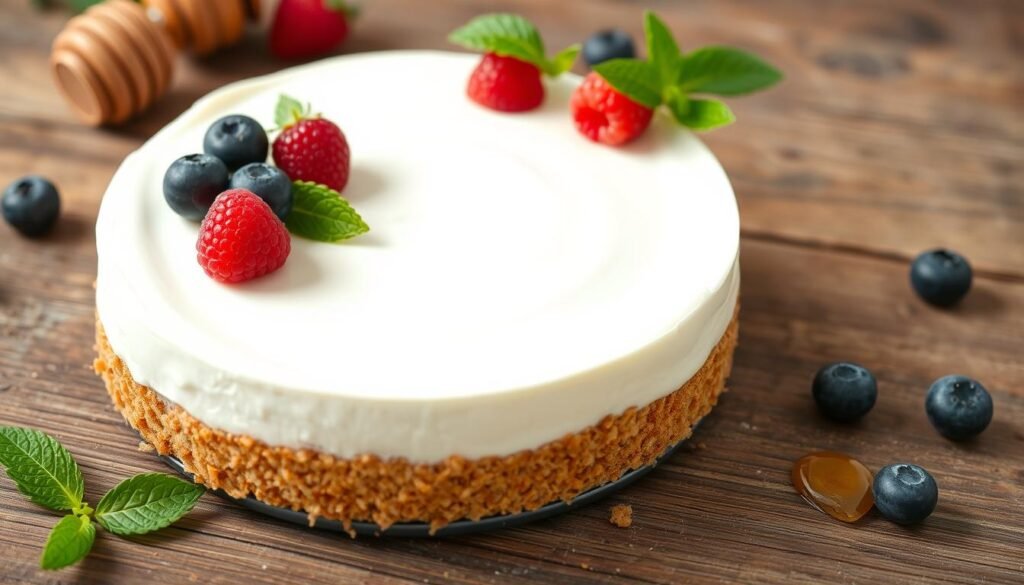
Begin with creamy Greek yogurt and low-fat cream cheese. Sweeten it with honey or maple syrup. Use gelatin or agar-agar to set it. Chill for 4–6 hours for a smooth dessert.
Here are some ways to add flavor:
- Add citrus zest or vanilla extract for brightness.
- Layer with berries or mango for natural sweetness.
- Freeze for 1–2 hours for a frosty twist.
Make mini cheesecakes in muffin tins for a fun twist. They’re perfect for picnics or as a cool dessert after dinner. This chilled healthy dessert is a hit at summer gatherings.
Flavor Variations to Keep Things Exciting
Trying new flavors makes healthy eating fun. Use berry cheesecake toppings like mixed berries or mango salsa for color and sweetness. A low-sugar fruit compote made with applesauce or banana can replace sugary glazes and add fiber.
Fruit-Based Toppings and Mix-ins
- Mix chopped pineapple or peaches into batter for tropical flair
- Drizzle honey-thinned apple butter over slices for a warm cinnamon kick
- Layer with kiwi or pomegranate seeds for crunch
Chocolate and Cocoa Variations
Make a healthy chocolate cheesecake base with dark cocoa powder. Add espresso powder for depth or fold in mini dark chocolate chips. A favorite trick: swirl in melted bittersweet chocolate for marbled effects.
Seasonal Adaptations
Change up your seasonal fruit desserts all year:
- Autumn: Add pumpkin puree + cinnamon for spiced versions
- Winter: Top with blood orange segments and rosemary sprigs
- Spring: Infuse with lavender syrup and strawberry coulis
“Seasonal ingredients offer peak nutrients and cost savings,” says registered dietitian Elena Torres. “Frozen fruits work perfectly for winter bakes!”
Pair seasonal produce with creative techniques. Roast figs for fall or freeze mango cubes for summer bakes. Let your imagination run wild while keeping ingredients balanced at 70% fruit-to-filling ratio.
How to Serve Your Healthy Cheesecake
Make your healthy cheesecake a standout with dessert presentation ideas. Begin by cutting it into neat slices with a hot knife for clean edges. Serve on small plates to highlight portion control desserts that are filling yet not too much.
- Garnish simply: Top with a berry compote, a mint leaf, or dark cocoa for healthy dessert garnishes that bring color without extra calories.
- Temperature matters: Let the cheesecake sit at room temperature for 10–15 minutes before serving. This improves flavor and texture.
- Individual servings: For parties, serve mini cheesecakes in ramekins or glass cups for elegant healthy dessert serving that feels fancy.
Pair it with fresh fruit salads or vanilla-infused whipped cream from low-fat yogurt. Add a citrus zest or edible flowers for a pop of color without sugar. Remember, portion control is about enjoying each bite fully. Serve with a smile, knowing every detail boosts both health and pleasure.
Storage Tips to Maintain Freshness
Proper how to store cheesecake ensures your creation stays delicious and safe to eat. Follow these simple steps to enjoy creamy texture and flavor every time.
Refrigeration Guidelines
Keep your cheesecake fresh in the fridge using these tips:
- Use airtight containers or wrap tightly with parchment and plastic wrap
- Store at 34–40°F (1–4°C) for up to 5 days
- Place on the middle shelf away from strong-smelling foods
| Storage Method | Max Time |
|---|---|
| Refrigeration | 5 days |
| Freezer | 3 months |
Freezing and Thawing Methods
Turn your treat into freezer-friendly healthy desserts with these steps:
- Wrap in parchment paper first, then aluminum foil
- Label with date before freezing
- Thaw overnight in fridge—never at room temperature
Portion Control Strategies
Master meal prep dessert ideas by:
- Baking in muffin tins for individual cheesecake portions
- Freezing pre-portioned slices in labeled containers
- Using silicone molds for easy removal
Pro tip: Portioning before freezing cuts prep time and helps with mindful eating!
Adapting the Recipe for Special Dietary Needs
Everyone deserves a slice of cheesecake, no matter their dietary needs. Here’s how to tweak the recipe to fit any lifestyle:
- Gluten-free cheesecake crust: Swap traditional graham crackers for almond flour blended with melted coconut oil. Try ¼ cup coconut sugar and ¼ cup sunflower seeds for crunch.
- Dairy-free cheesecake recipe: Use cashew cream (soaked and blended) or coconut cream as a base. Brands like Kite Hill or Miyoko’s offer plant-based cream cheese that work well.
- Keto-friendly cheesecake: Boost fats with avocado puree mixed into the filling. Replace honey with erythritol (1:1 ratio) and use Swerve or Lakanto for sweetness without carbs.
- Sugar-free dessert options: Stevia drops or monk fruit sweetener cut calories. Pair with sugar-free chocolate chips or fresh berries as toppings.
For paleo diets, omit oats and use flaxseed meal as a binder. Vegan egg replacers like Bob’s Red Mill Egg Replacer work in binding crusts. Always check labels for cross-contamination warnings if avoiding allergens.
Experimenting with these swaps keeps the texture creamy and flavors rich. Share recipes with friends—adaptations make dessert inclusive for all!
Conclusion: Enjoying Dessert as Part of a Balanced Lifestyle
Enjoying treats doesn’t have to ruin your health goals. Our recipe shows how to balance sweets with a healthy lifestyle. By choosing whole foods and mindful eating, you feed your body and enjoy treats. This guilt-free treat philosophy makes dessert a joyful moment, not a stress.
Practicing mindful eating helps you know when you’re really hungry. Enjoy each bite of this cheesecake, feeling its creaminess and flavors. Remember, healthy dessert habits are about quality, not cutting out treats. Small changes like Greek yogurt or nut-based crusts show that you can have both nutrition and indulgence.
Try adding seasonal berries, dark chocolate swirls, or vegan options to keep things interesting. Every change shows that balance is about making smart choices, not cutting out things you love. Whether baked or no-bake, this recipe encourages you to be flexible with your eating.
Share your creations with others! Tag us when you try new toppings or crusts. Let’s build a community that loves enjoying desserts mindfully. Your wellness journey can include sweet moments—just make them count. After all, a balanced approach to sweets means you don’t have to choose between flavor and nutrition. Savor every bite, and keep exploring what works best for you.
FAQ
Why should I choose a healthy cheesecake over a traditional one?
Healthy cheesecakes have fewer calories, fat, and sugars. They’re a guilt-free treat that lets you enjoy dessert without harming your health goals.
What are the health benefits of Greek yogurt in the cheesecake recipe?
Greek yogurt boosts protein and calcium. It makes the cheesecake creamy without the heavy feel of cream cheese.
Can I make a healthy cheesecake without baking it?
Yes! No-bake cheesecakes are easy to make. They keep their texture well and are great for hot weather or when you’re short on energy.
What are some natural sweeteners I can use instead of refined sugar?
Try honey, maple syrup, monk fruit extract, or dates. They’re sweeter and have more nutrients than refined sugar.
How can I customize my healthy cheesecake for different flavors?
Add fruit purees, chocolate, or spices to the mix. This way, you can make flavors like berry swirl, chocolate mocha, or pumpkin spice.
What storage tips do I need to follow to keep my cheesecake fresh?
Keep your cheesecake in an airtight container in the fridge for up to 5 days. Freeze it for longer storage. Make sure to wrap individual slices well.
How can I adapt the recipe for gluten-free or vegan diets?
For gluten-free, use almond flour or gluten-free cookies for the crust. For vegan, replace dairy with cashew cream or coconut yogurt.
Can I make individual servings of healthy cheesecake?
Yes! Use muffin tins or small glass jars for mini cheesecakes. They’re great for portion control and look cute.
What is the best way to serve a healthy cheesecake to make it feel special?
Serve with fresh berries, mint leaves, or a fruit coulis drizzle. It makes the cheesecake look and taste better.



